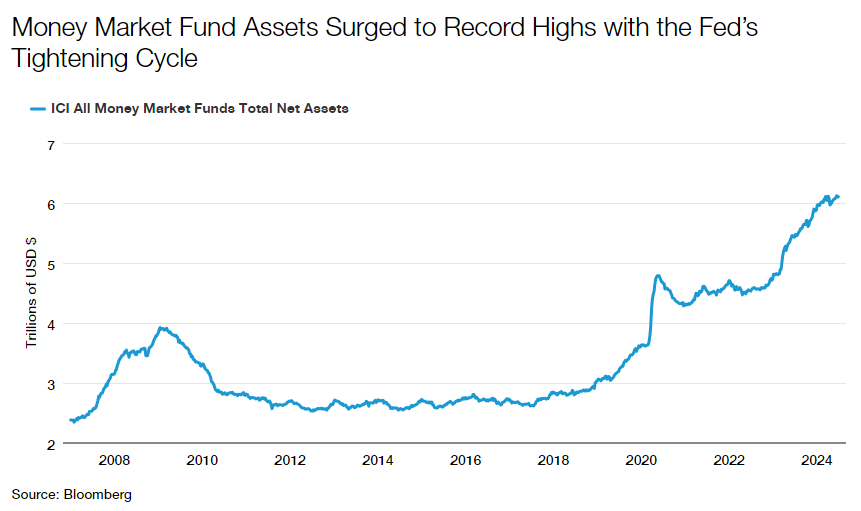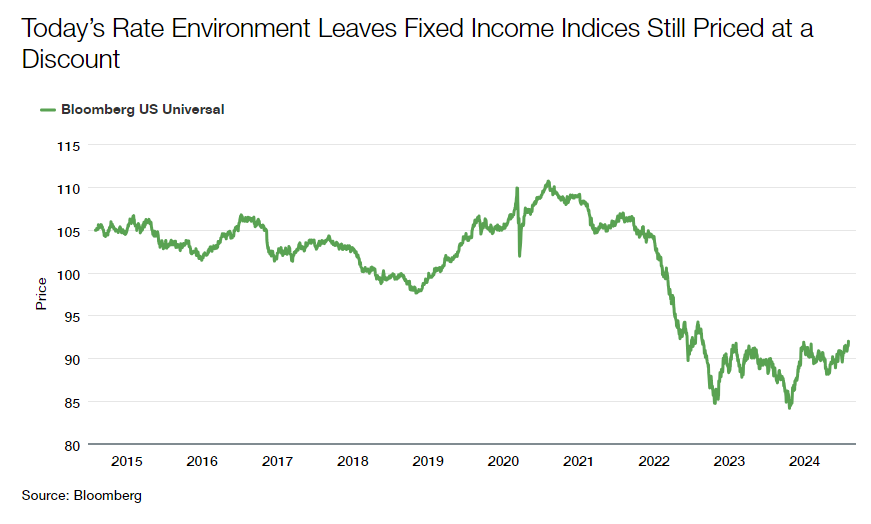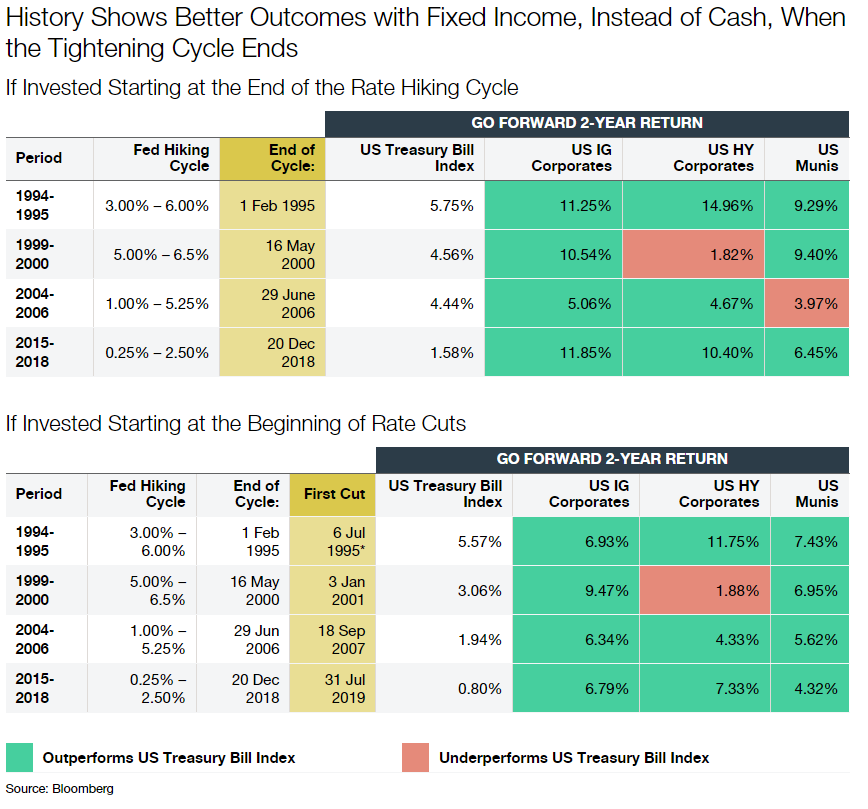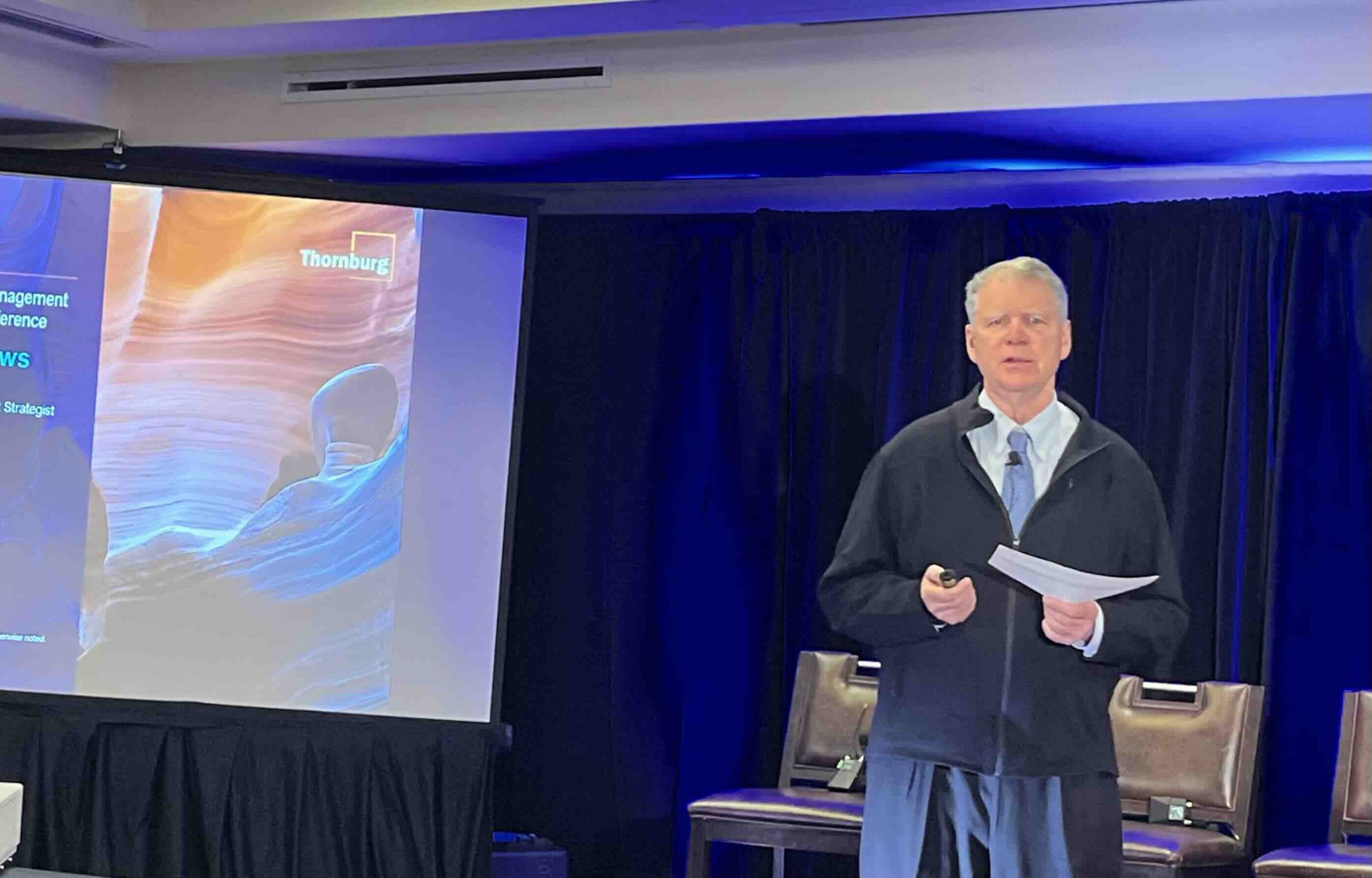In the world of investing, fixed income has traditionally been associated with stability and income generation. This role has been uniquely challenged since the spring of 2022, when the Federal Reserve (the Fed) embarked on a series of massive rate hikes – at one point, four 75 basis points hikes in a row – which the markets had not experienced in a generation. Not surprisingly, many fixed income strategies and indices posted the worst total returns in their history. Naturally, many investors flocked to the front end of the curve, taking advantage of elevated yields. However, the tide is turning, with the Federal Reserve expected to cut rates multiple times over the next year.
Let’s begin by discussing the post-pandemic interest rate environment, specifically the implications of the Fed’s hiking cycle. The Fed and other central banks used their policy rates as tools to bring exceedingly elevated levels of inflation back towards what they deem to be “normal” or within their respective target ranges. Risky asset markets rallied in response to the improvement in inflation data in the absence (so far) of a U.S. recession. Further, the hiking cycle led to attractive yield generation in short-term instruments like Treasury bills, money market funds, and certificates of deposit (CDs). As of mid-summer 2023, the 6-month Treasury bill yielded nearly 5.5%, the highest level since 2000. As yields rose, the money followed, with prime and taxable money market funds taking in a combined $965 billion in flows for the calendar year 2023, per Morningstar. Contrast this to the active taxable bond space, which has experienced a net inflow of just $33 billion over the same period.

Rising rates had the effect of increasing the coupons paid on new fixed income securities, which should support forward looking returns. But perhaps more importantly, the rate sell-off decreased the dollar price of bonds already in existence, many of which are government or investment-grade corporate bonds with low credit risk. As a result, the bond market is priced at a discount even though fixed income securities, with the exception of a default event, mature at “par” or $100. It is this “pull to par” that should drive attractive returns going forward as rates potentially fall in response to a Fed policy pivot.
The term “pull-to-par” refers to the tendency of fixed income securities to move towards their face value (par value, or $100) as they approach maturity. Bonds priced at a discount will see their prices rise as they get closer to maturity, while bonds trading at a premium (that is, above $100) will see their values fall to par over time. In today’s environment, with the Fed near the beginning of rate cuts (as of this writing), fixed income securities with prices below their par value have potential for meaningful price appreciation. That appreciation, in addition to regular coupon payments, leads to larger total returns for investors. We believe this total return likely eclipses the yields that may be earned on short-end instruments going forward.
To illustrate how unique the current fixed income environment is, let’s examine historical price data for various fixed income indices over the last 10 years. The chart below shows the average price for the Bloomberg U.S. Universal Index. For the vast majority of the 10-year period, the average price for the index was either near or above par, with the mean dollar price at about $100.50. Rising rates drove the average dollar prices of the index, and active portfolios as well, down to near unprecedented levels, below $92 as of July 31st, 2024. Given the quality of the constituents of the index, it is reasonable for an investor to believe that these bonds will pull back to par as they get closer to maturity, thereby providing investors with an additional boost to performance over and above just clipping coupon payments.

Another lens to look at the relative value of owning fixed income versus cash instruments can be seen in historical data on how both have performed in an environment similar to the present one, that is, with the Fed pivoting to rate cuts. We looked at data for the last four Fed tightening cycles going back to the mid-1990s to see how both cash and fixed income performed both prior to and when the Fed began cutting interest rates. We used the ICE BofA U.S. Treasury Bill Index as a proxy for short-term instruments and selected four Bloomberg indices representing both above and below investment-grade securities for fixed income. As the table shows, the subsequent two-year returns produced, in most cases, better economic outcomes when owning fixed income as opposed to staying invested in Treasury bills. These results are consistent when cash was deployed at the end of the hiking cycles or the beginning of cuts, though investors did better by not waiting for the Fed to deliver cuts first. In the current environment with the Fed posed to ease, and with an elevated chance of economic weakness going into 2025, fixed income has a similar potential to outperform cash instruments this time around.

By combining the return generators of coupons and the “pull-to-par” effect as rates potentially fall, investors may outperform Treasury bills, CDs, and money market funds in the months and years ahead. We believe active management remains valuable for capturing these excess returns and potentially adding alpha over benchmark indices. Many fixed income securities with attractive risk and reward characteristics, such as shorter-dated, investment-grade rated bonds within the asset-backed securities and residential mortgage space, sit outside of benchmarks and represent some of today’s most compelling opportunities.
The concept of earning coupon plus the pull-to-par represents a valuable opportunity for fixed income investors as the Fed considers rate cuts. By understanding how this phenomenon impacts fixed income securities’ total return, investors can capitalize on the current opportunity it presents. When combined with effective active management strategies, the pull-to-par effect may serve as a powerful tool to achieve outperformance and enhance overall returns. But timing is of the essence. Yields today still look to be interesting even in a high-quality portfolio. So now is the time to make those moves, not to wait until yields fall further
Opinion article by Rob Costello, client portfolio manager in Thornburg Investment Management.
Important Information
The views expressed are subject to change and do not necessarily reflect the views of Thornburg Investment Management, Inc. This document is for informational purposes only and does not constitute a recommendation or investment advice and is not intended to predict the performance of any investment or market. It should not be construed as advice as to the investing in or the buying or selling of securities, or as an activity in furtherance of a trade in securities.
This is not a solicitation or offer for any product or service or an offer or solicitation for the purchase or sale of any financial instrument, product or service sponsored by Thornburg or its affiliates. Nor is it a complete analysis of every material fact concerning any market, industry, or investment. Data has been obtained from sources considered reliable, but Thornburg makes no representations as to the completeness or accuracy of such information and has no obligation to provide updates or changes. Thornburg does not accept any responsibility and cannot be held liable for any person’s use of or reliance on the information and opinions contained herein. The views expressed herein may change at any time after the date of this publication. There is no guarantee that any projection, forecast or opinion in this material will be realized.
Investments carry risks, including possible loss of principal.





